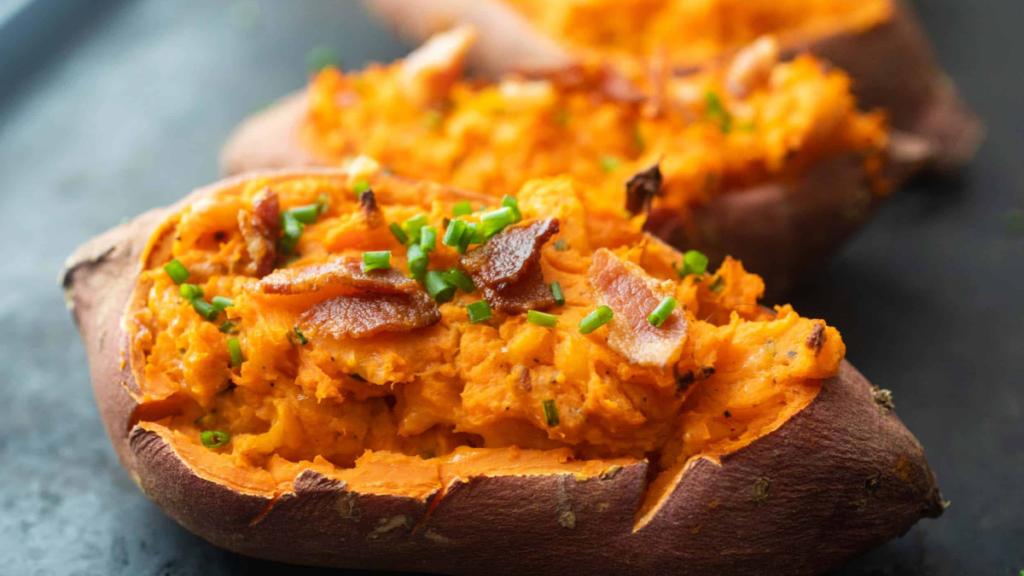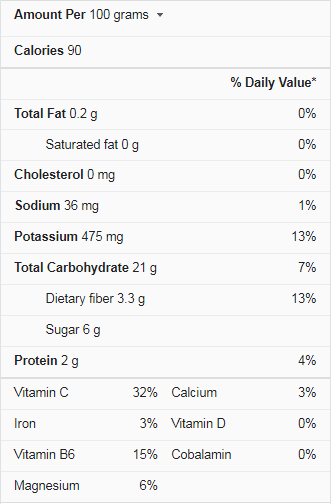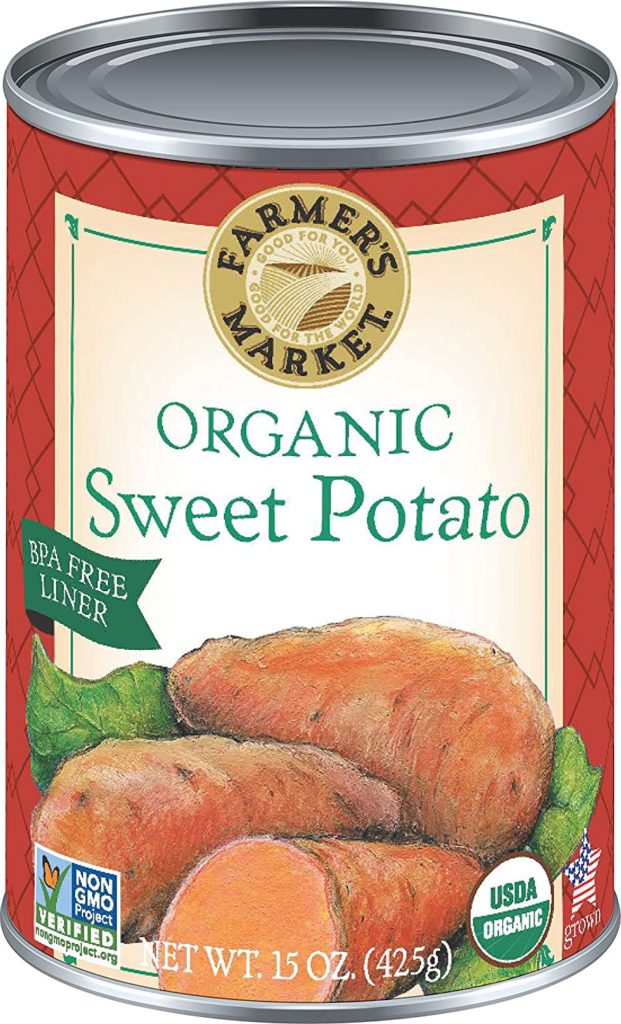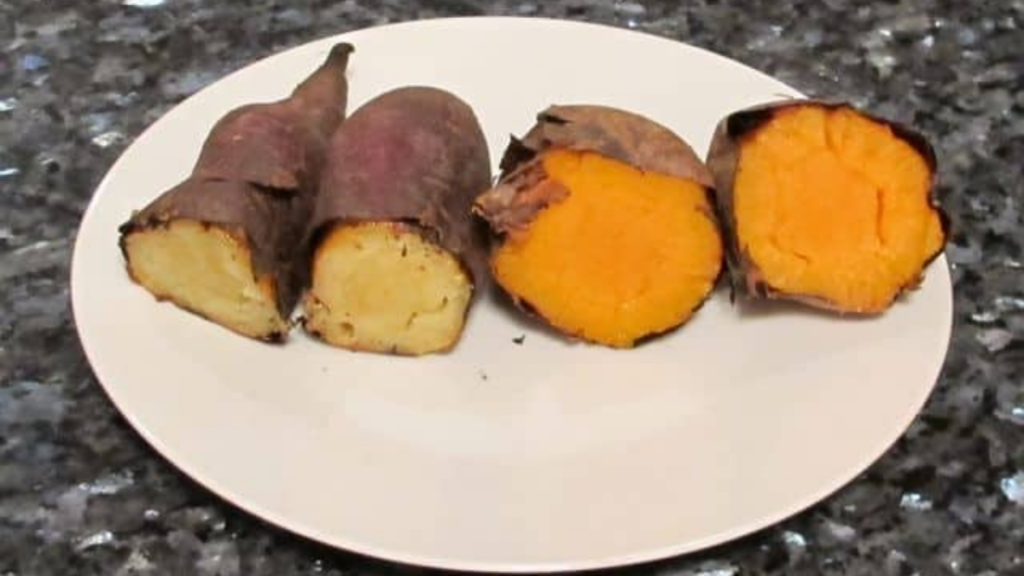Sweet potatoes are a tasty and healthy food that many people worldwide enjoy. With its vibrant color, delicious flavor, and numerous health benefits, it’s no wonder that sweet potatoes have become a staple in many households. In this article, we’ll be taking a closer look at the nutrition facts for 1 baked sweet potato and exploring what makes this food so beneficial for our health. From its high fiber content to its rich source of antioxidants, you’ll discover why sweet potatoes are a must-have ingredient in any healthy diet.
The GI value of a baked sweet potato is low to medium compared to its other cooking methods, such as boiling or roasting. A medium-sized baked sweet potato has 27 grams of carbs, and these carbohydrates are primarily starches, with only 32% from simple sugars. The glycemic index of sweet potatoes is high to medium, so eating a large portion might not be a good idea for those with type 2 diabetes.
Baked Sweet Potato Nutrition Facts
A medium-sized baked sweet potato contains more than 100 percent of the Recommended Daily Allowance of Vitamin A. However, despite its low-calorie content, a baked sweet potato is highly antioxidant and contains fewer calories than a standard-sized orange or yellow potato. The nutrients are broken down into soluble and insoluble fibers. As a result, the nutrient value per serving is higher than a similar-sized white or yellow potato.
Carbs
The carb content of a medium-sized sweet potato (cooked without the skin) is 27 grams. Starches make up most of the carbs, accounting for 53% of the total. Simple sugars like glucose, fructose, sucrose, and maltose make up 32% of the carbohydrate composition.
Sweet potatoes have a glycemic index (GI) of 44–96, ranging from mild to high. The glycemic index (GI) measures how quickly your blood sugar levels rise after eating.
Large portions of sweet potatoes in a single meal may be undesirable for patients with type 2 diabetes due to their relatively high GI. Boiling, in particular, appears to be linked to lower GI values than baking, frying, or roasting.
Starch
Starches are usually divided into three types based on how well they’re digested. The following are the starch proportions in sweet potatoes.
- Rapidly digested starch (80%) – The GI value is increased since it is swiftly broken down and absorbed.
- Resistant starch (11%)- This gets through digestion and works like fiber, feeding your good bacteria in the stomach. The amount of resistant starch in sweet potatoes can be increased somewhat by allowing them to cool after cooking.
- Slowly digested starch (9%) – This kind degrades more slowly, resulting in a slower rise in blood sugar levels.
Fiber
Cooked sweet potatoes have significant fiber content, with 3.8 grams in a medium-sized sweet potato. The fibers are soluble (15–23%) in pectin and insoluble (77–85%) in cellulose, hemicellulose, and lignin.
Soluble fibers like pectin can help you feel fuller, eat less, and have fewer blood sugar spikes by slowing the digestion of carbohydrates and starches. Insoluble fiber consumption has been linked to various health benefits, including a lower risk of diabetes and better gut health.
Protein
Sweet potatoes are a significant source of protein in many underdeveloped nations, despite their low protein content. Sweet potatoes are an important source of protein in many underdeveloped countries, despite their low protein content.
It has sprains, and unique proteins that make up more than 80% of its total protein content. The sprains are created to help the plant repair after being physically damaged, and according to recent studies, they may have antioxidant effects. A medium sweet potato has only 2 grams of protein, making it a poor source of protein.
Farmer’s Market Foods Canned Organic Sweet Potato
Features
Sweet potatoes vs. Regular Potatoes
- Many prefer sweet potatoes to regular potatoes because they believe they are healthier.
- Both species have similar water, carbohydrates, fat, and protein content.
- Sweet potatoes, in particular, have a lower GI and contain more sugar and fiber than other vegetables.
- Both are high in vitamin C and potassium, but sweet potatoes also include a lot of beta-carotene, which your body can convert into vitamin A.
- Regular potatoes may be more satisfying but may also include high doses of glycoalkaloids, which can be dangerous.
- Sweet potatoes are frequently considered the better option due to their high fiber and vitamin content.
What are the Health Benefits of Sweet Potatoes?
Sweet potatoes provide several health benefits:
Prevention of Vitamin A Deficiency:
Vitamin A insufficiency is a substantial public health issue in many underdeveloped nations since it plays a crucial role in your body. Deficiency can harm your eyes in the short and long term and even lead to blindness. It can also impair immunological function and raise mortality rates, particularly in youngsters and pregnant or lactating women.
Sweet potatoes are abundant in beta-carotene, which your body can convert to vitamin A. A sweet potato’s amount of beta carotene is proportional to its yellow or orange hue intensity. Because they include a highly absorbable form of vitamin A, orange sweet potatoes have been proven to enhance blood levels of this nutrient more than other beta-carotene sources.
Improved Blood Sugar Regulation:
Type 2 diabetes is characterized by an imbalance in blood sugar levels and insulin production. Quiapo, a sweet potato with white skin and flesh, may help persons with type 2 diabetes manage their symptoms.
This sweet potato may improve insulin sensitivity and lower fasting blood glucose and LDL (harmful) cholesterol levels. On the other hand, the current evidence does not support the use of sweet potatoes in treating type 2 diabetes, and more human research is required.
Reduced Oxidative Damage and Cancer Risk:
Sweet potatoes’ powerful antioxidants have been shown in studies to lower cancer risk, and the antioxidant activity of purple potatoes is the highest.
Cell oxidative damage is frequently linked to a higher cancer risk, which arises when cells divide uncontrolled. Antioxidant-rich diets, such as carotenoids, have been linked to reduced stomach, kidney, and breast cancer.
Potential Downsides:
Sweet potatoes are a low-cost, easy-to-incorporate food in your diet. Sweet potatoes are a nutritious, low-cost, and simple food to incorporate into your diet. The majority of people tolerate sweet potatoes quite well. They do, however, contain a lot of oxalates, which can increase your chances of developing kidney stones. People who are prone to kidney stones should avoid eating sweet potatoes.
While yams are similar to sweet potatoes, the former is much more nutritious. Soluble pectin fiber is the most abundant fiber in a cooked sweet potato. Soluble pectin fiber is the largest fiber in a cooked sweet potato.
The % Daily Value of a medium-sized sweet potato is 138 calories, split into six grams of carbohydrates, 7% protein, and 25% fat. Hence, one medium-sized sweet potato contains about 3% of these components.





